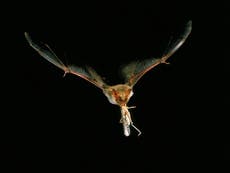The pandemic has revived the demonisation of bats, but they aren’t the villains – we are
We have a lot to thank them for but sadly bats face growing threats of extinction. The primary cause of their decline? Human activity

Your support helps us to tell the story
From reproductive rights to climate change to Big Tech, The Independent is on the ground when the story is developing. Whether it's investigating the financials of Elon Musk's pro-Trump PAC or producing our latest documentary, 'The A Word', which shines a light on the American women fighting for reproductive rights, we know how important it is to parse out the facts from the messaging.
At such a critical moment in US history, we need reporters on the ground. Your donation allows us to keep sending journalists to speak to both sides of the story.
The Independent is trusted by Americans across the entire political spectrum. And unlike many other quality news outlets, we choose not to lock Americans out of our reporting and analysis with paywalls. We believe quality journalism should be available to everyone, paid for by those who can afford it.
Your support makes all the difference.Bats have had a bad press this year. A majority of scientists believe that Covid-19 was introduced to humans by cross-infection from an animal species, with bats the prime suspects.
People have always been suspicious and fearful of bats so we needed little encouragement to point the finger their way. Some media outlets have even called for a global genocide of all bats. Of course, all this recrimination is a defence mechanism that stops us having to look closer to home.
It’s a shame we’re so quick to judge because bats are wonderful, fascinating creatures. They have been on Earth for more than 50 million years – far longer than humans – and there are more than 1,400 different species of them, meaning around 20 per cent of the world’s mammal species are bats.
They come in all shapes and sizes: from the Kitti’s hog-nosed species, which weighs just two grams, to the golden-crowned flying fox, with its majestic wingspan of up to six feet. Some bats are as small as bee, others are the size of a dog. They can live for up to 30 years and are more closely related to humans than they are to mice.
Contrary to a popular myth, bats are not blind but actually have small eyes with very sensitive vision. In fact, according to the Organization for Bat Conservation, some larger bats can see three times better than humans can.
They’re intelligent creatures that can migrate across multiple continents and then fly back to their original location. Some are super-speedy too: the Mexican free-tailed bat can fly at speeds of up to 100mph.
Bats do so much for humans. Some eat 4,000 insects per night, which makes life easier for farmers, whose crops would otherwise be covered in chemicals or destroyed by the insects. In some parts of Europe, farmers have been able to stop using pesticides in their rice paddies simply by attracting hungry bats. The farmers say these bats are saving them tens of billions of pounds each year.
Hundreds of plant species also rely on bats for pollination. Tequila bosses say their industry would collapse without bats, who are the chief pollinators of agave plants, used to make the popular drink. Bats also play a critical role in spreading the seeds of trees and other plants, which produce everything from dates to vanilla, and balsa wood to chewing gum.
We have a lot to thank them for but sadly bats face growing threats of extinction and the primary cause of their decline worldwide is human activity. We rapaciously destroy their natural habitat, condemning them to homelessness and a diminished food supply.
In some parts of the world, people hunt bats for sport and for meat. Others cause harm unwittingly by putting artificial lights by their roosts or chemical treatments on the modern buildings around them. Anglers sometimes catch them by mistake on fishing hooks, and they also perish when they collide with wind turbines or get stuck in flypaper.
Perhaps the worst impact is the scandalous vivisection experiments done inside secretive laboratories. These fascinating, delicate animals should be flying free in nature, not tied down in labs, cut, abused and killed by heartless scientists. Yet we never learn: even though human interference with bats almost certainly caused Covid-19, scientists continue to catch them and exploit them in laboratories.
Many humans remain uncaring towards bats for two reasons. Firstly, there is their association with horror and blood. This is a Hollywood myth. Only vampire bats – three tiny species, all found in Central and South America – feed on the blood of animals. The fear of bats flying into you and getting entangled in your hair is also misplaced because bats are extremely keen to avoid contact with humans.
The second reason is part of the wider state of human denial over our relationship with animals. For instance, many meat-eaters truly believe that the animals they’re eating enjoyed a long and happy life on humane farms before they met their end. Yet 73 per cent of farmed animals in the UK are kept in intensive factory farms – with 99 per cent in the US.
As for that “long and happy life”, chickens, which can live up to eight years in natural conditions, are usually killed for flesh at just six weeks; pigs are allowed just six months of their 11-year lifespan; and cows, who could live up to 20 years, are killed at just 18 months. During those short lives, they will be mutilated – for example, their testicles cut off without anaesthetic – and kept in frightening, unnatural conditions. So, meat-eaters are not eating what they believe. They eat babies that lived short, sad lives in cruel prisons.
When the animals we love and recognise are treated this way, what hope do mysterious, demonised bats have? Even though it was human exploitation of bats that caused Covid-19, we blame them for it. It’s the same arrogant inversion that sees westerners blame refugees for their fate, rather than seeing our country’s imperialist exploitative role in their plight.
We need to look closer to home. If we weren’t “blind as bats”, we’d see that they aren’t the villains – we are.





Join our commenting forum
Join thought-provoking conversations, follow other Independent readers and see their replies
Comments